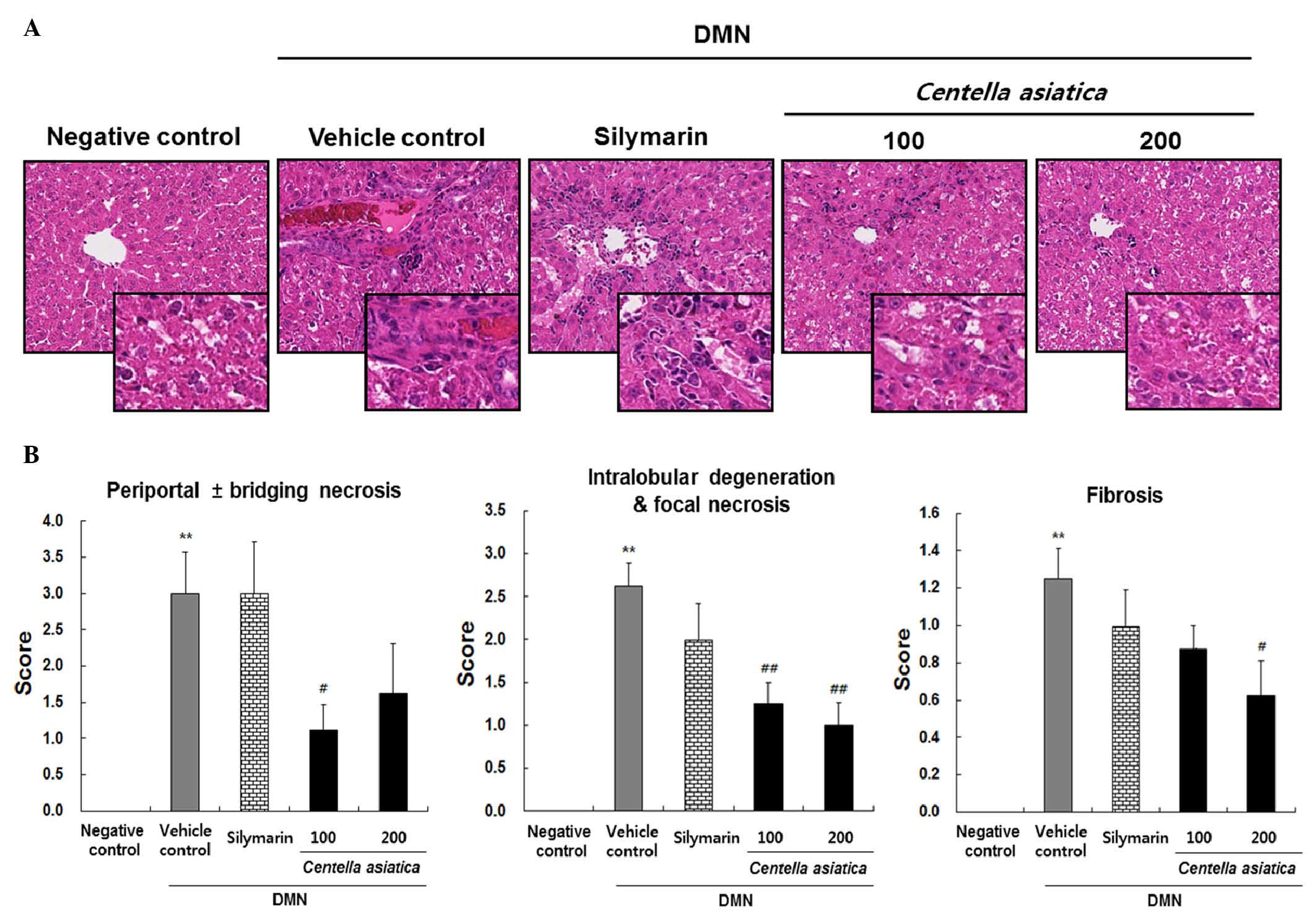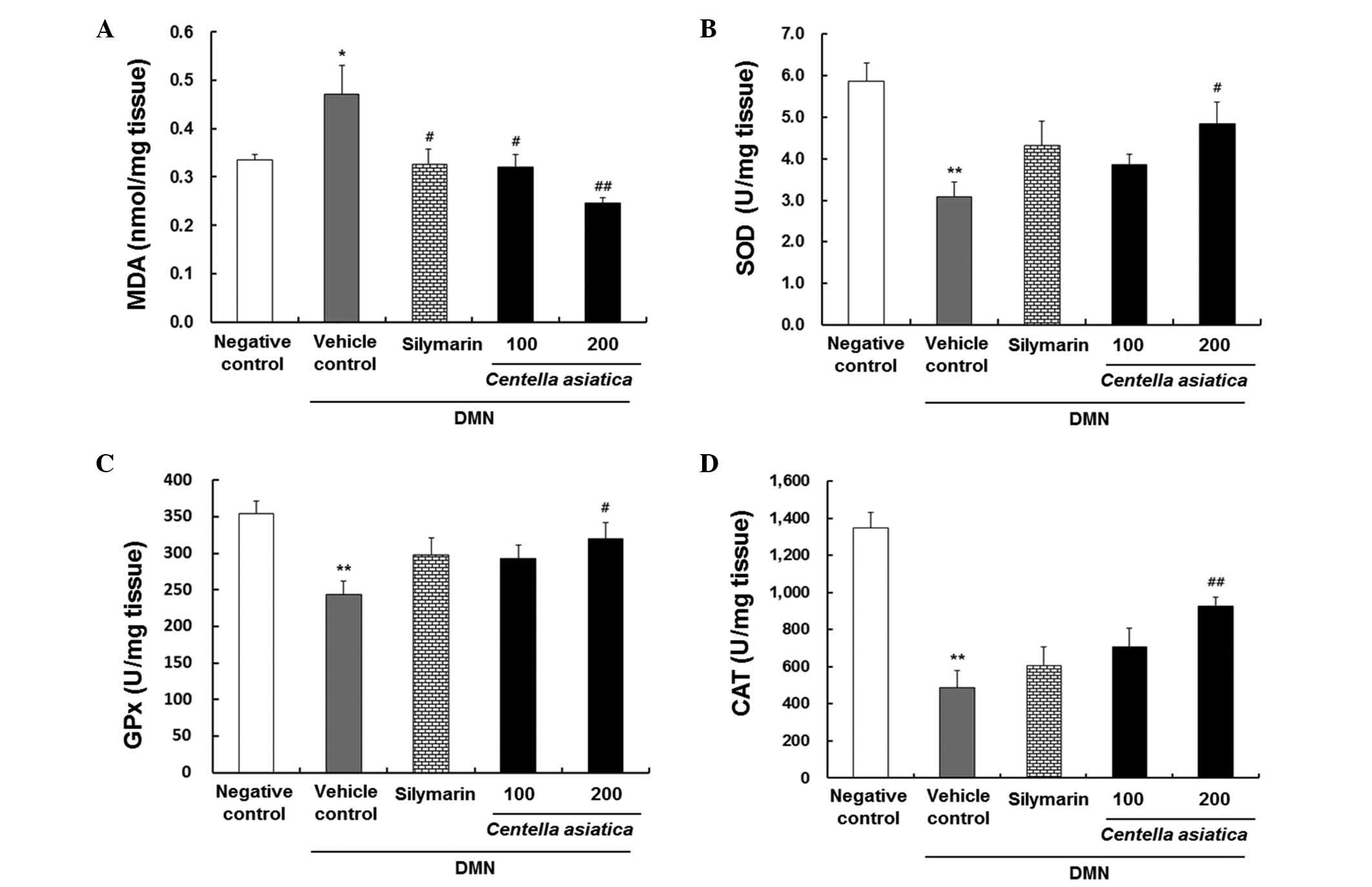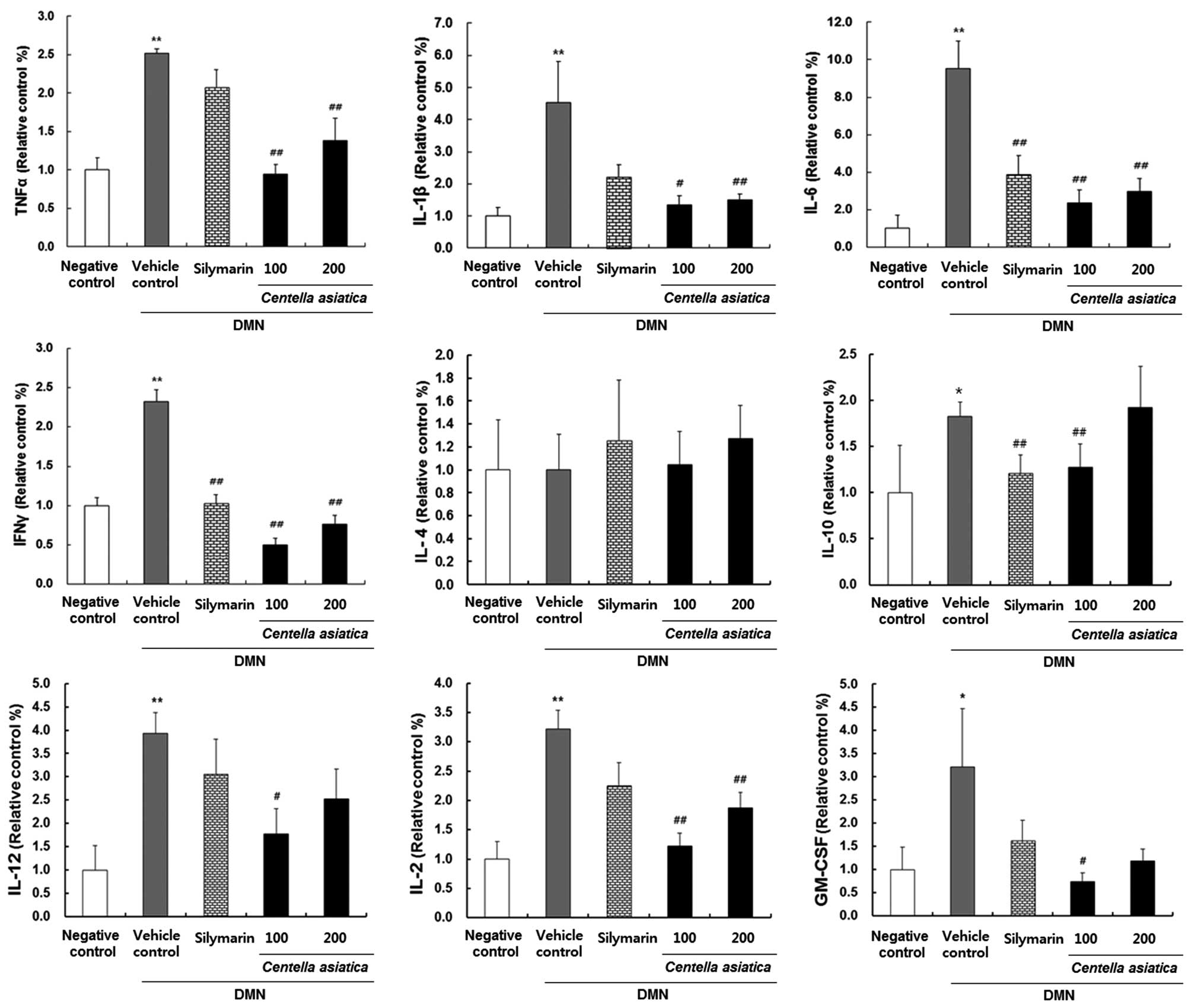|
1
|
George J, Rao KR, Stern R and Chandrakasan
G: Dimethylnitrosamine-induced liver injury in rats: The early
deposition of collagen. Toxicology. 156:129–138. 2001. View Article : Google Scholar : PubMed/NCBI
|
|
2
|
Guengerich FP, Kim DH and Iwasaki M: Role
of human cytochrome P-450 IIE1 in the oxidation of many low
molecular weight cancer suspects. Chem Res Toxicol. 4:168–179.
1991. View Article : Google Scholar : PubMed/NCBI
|
|
3
|
Jin YL, Enzan H, Kuroda N, Hayashi Y,
Nakayama H, Zhang YH, Toi M, Miyazaki E, Hiroi M, Guo LM and
Saibara T: Tissue remodeling following submassive hemorrhagic
necrosis in rat livers induced by an intraperitoneal injection of
dimethylnitrosamine. Virchows Arch. 442:39–47. 2003.PubMed/NCBI
|
|
4
|
Teufelhofer O, Parzefall W, Kainzbauer E,
Ferk F, Freiler C, Knasmüller S, Elbling L, Thurman R and
Schulte-Hermann R: Superoxide generation from kupffer cells
contributes to hepatocarcinogenesis: Studies on NADPHoxidase
knockout mice. Carcinogenesis. 26:319–329. 2005. View Article : Google Scholar : PubMed/NCBI
|
|
5
|
Wills PJ, Suresh V, Arun M and Asha VV:
Antiangiogenic effect of lygodium flexuosum against
N-nitrosodiethylamine-induced hepatotoxicity in rats. Chem Biol
Interact. 164:25–38. 2006. View Article : Google Scholar : PubMed/NCBI
|
|
6
|
Pradeep K, Mohan CV, Gobianand K and
Karthikeyan S: Effect of Cassia fistula linn. Leaf extract on
diethylnitrosamine induced hepatic injury in rats. Chem Biol
Interact. 167:12–18. 2007. View Article : Google Scholar : PubMed/NCBI
|
|
7
|
Jayakumar S, Madankumar A, Asokkumar S,
Raghunandhakumar S, dhas K Gokula, Kamaraj S, Divya MG and Devaki
T: Potential preventive effect of carvacrol against
diethylnitrosamine-induced hepatocellular carcinoma in rats. Mol
Cell Biochem. 360:51–60. 2012. View Article : Google Scholar : PubMed/NCBI
|
|
8
|
Caro AA and Cederbaum AI: Oxidative
stress, toxicology and pharmacology of CYP2E1. Annu Rev Pharmacol
Toxicol. 44:27–42. 2004. View Article : Google Scholar : PubMed/NCBI
|
|
9
|
Cressman DE, Greenbaum LE, DeAngelis RA,
Ciliberto G, Furth EE, Poli V and Taub R: Liver failure and
defective hepatocyte regeneration in interleukin-6-deficient mice.
Science. 274:1379–1383. 1996. View Article : Google Scholar : PubMed/NCBI
|
|
10
|
Tilg H and Diehl AM: Cytokines in
alcoholic and nonalcoholic steatohepatitis. N Engl J Med.
343:1467–1476. 2000. View Article : Google Scholar : PubMed/NCBI
|
|
11
|
Guan L, Fu PY, Li PD, Li ZN, Liu HY, Xin
MG and Li W: Mechanisms of hepatic ischemia-reperfusion injury and
protective effects of nitric oxide. World J Gastrointest Surg.
6:122–128. 2014. View Article : Google Scholar : PubMed/NCBI
|
|
12
|
Schümann J, Prockl J, Kiemer AK, Vollmar
AM, Bang R and Tiegs G: Silibinin protects mice from T
cell-dependent liver injury. J Hepatol. 39:333–340. 2003.
View Article : Google Scholar : PubMed/NCBI
|
|
13
|
Radaeva S, Sun R, Jaruga B, Nguyen VT,
Tian Z and Gao B: Natural killer cells ameliorate liver fibrosis by
killing activated stellate cells in NKG2D-dependent and tumor
necrosis factor-related apoptosis-inducing ligand-dependent
manners. Gastroenterology. 130:435–452. 2006. View Article : Google Scholar : PubMed/NCBI
|
|
14
|
Halliwell B and Gutteridge JM: Role of
free radical and catalytic metal ions in human disease: An
overview. Methods Enzymol. 186:1–85. 1990. View Article : Google Scholar : PubMed/NCBI
|
|
15
|
Suguna L, Sivakumar P and Chandrakasan G:
Effects of Centella asiatica extract on dermal wound healing in
rats. Indian J Exp Biol. 34:1208–1211. 1996.PubMed/NCBI
|
|
16
|
Kumar Veerendra MH and Gupta YK: Effect of
different extracts of Centella asiatica on cognition and markers of
oxidative stress in rats. J Ethnopharmacol. 79:253–260. 2002.
View Article : Google Scholar : PubMed/NCBI
|
|
17
|
Babu TD, Kuttan G and Padikkala J:
Cytotoxic and anti-tumour properties of certain taxa of
umbelliferae with special reference to Centella asiatica (L.)
urban. J Ethnopharmacol. 48:53–57. 1995. View Article : Google Scholar : PubMed/NCBI
|
|
18
|
Sairam K, Rao CV and Goel RK: Effect of
Centella asiatica linn on physical and chemical factors induced
gastric ulceration and secretion in rats. Indian J Exp Biol.
39:137–142. 2001.PubMed/NCBI
|
|
19
|
Katare SS and Ganachari MS: Effect of
Centella asiatica on hypoxia induced convulsions and
lithium-pilocarpine induced status epilepticus and antilipid
peroxidation activity. Ind J Pharmacol. 33:1282001.
|
|
20
|
Jayashree G, Muraleedhara G Kurup,
Sudarslal S and Jacob VB: Anti-oxidant activity of Centella
asiatica on lymphoma-bearing mice. Fitoterapia. 74:431–434. 2003.
View Article : Google Scholar : PubMed/NCBI
|
|
21
|
Brunt EM: Grading and staging the
histopathological lesions of chronic hepatitis: The knodell
histology activity index and beyond. Hepatology. 31:241–246. 2000.
View Article : Google Scholar : PubMed/NCBI
|
|
22
|
Miranda KM, Espey MG and Wink DA: A rapid,
simple spectrophotometric method for simultaneous detection of
nitrate and nitrite. Nitric Oxide. 5:62–71. 2001. View Article : Google Scholar : PubMed/NCBI
|
|
23
|
Ray SD, Sorge CL, Kamendulis LM and
Corcoran GB: Ca (++)-activated DNA fragmentation and
dimethylnitrosamine-induced hepatic necrosis: Effects of ca
(++)-endonuclease and poly (ADP-ribose) polymerase inhibitors in
mice. J Pharmacol Exp Ther. 263:387–394. 1992.PubMed/NCBI
|
|
24
|
Saad RA, EL-Bab MF and Shalaby AA:
Attenuation of acute and chronic liver injury by melatonin in rats.
J Taibah Univ Sci. 7:88–96. 2013. View Article : Google Scholar
|
|
25
|
Pinzani M and Rombouts K: Liver fibrosis:
From the bench to clinical targets. Dig Liver Dis. 36:231–242.
2004. View Article : Google Scholar : PubMed/NCBI
|
|
26
|
Sallie R, Tredger JM and Williams R: Drugs
and the liver. Part 1: Testing liver function. Biopharm Drug
Dispos. 12:251–259. 1991. View Article : Google Scholar : PubMed/NCBI
|
|
27
|
Zimmerman HJ: Hepatotoxicity. Dis Mon.
39:675–787. 1993.PubMed/NCBI
|
|
28
|
Nkosi CZ, Opoku AR and Terblanche SE:
Effect of pumpkin seed (Cucurbita pepo) protein isolate on the
activity levels of certain plasma enzymes in CCl4-induced liver
injury in low-protein fed rats. Phytother Res. 19:341–345. 2005.
View Article : Google Scholar : PubMed/NCBI
|
|
29
|
Lander HM: An essential role for free
radicals and derived species in signal transduction. FASEB J.
11:118–124. 1997.PubMed/NCBI
|
|
30
|
Rushmore TH and Kong AN: Pharmacogenomics,
regulation and signaling pathways of phase I and II drug
metabolizing enzymes. Curr Drug Metab. 3:481–490. 2002. View Article : Google Scholar : PubMed/NCBI
|
|
31
|
Vendemiale G, Grattagliano I, Caruso ML,
Serviddio G, Valentini AM, Pirrelli M and Altomare E: Increased
oxidative stress in dimethylnitrosamine-induced liver fibrosis in
the rat: Effect of N-acetylcysteine and interferon-alpha. Toxicol
Appl Pharmacol. 175:130–139. 2001. View Article : Google Scholar : PubMed/NCBI
|
|
32
|
Gnanapragasam A, Ebenezar KK, Sathish V,
Govindaraju P and Devaki T: Protective effect of Centella asiatica
on antioxidant tissue defense system against adriamycin induced
cardiomyopathy in rats. Life Sci. 76:585–597. 2004. View Article : Google Scholar : PubMed/NCBI
|
|
33
|
Gupta YK, Kumar MH Veerendra and
Srivastava AK: Effect of Centella asiatica on
pentylenetetrazole-induced kindling, cognition and oxidative stress
in rats. Pharmacol Biochem Behav. 74:579–585. 2003. View Article : Google Scholar : PubMed/NCBI
|
|
34
|
Haleagrahara N and Ponnusamy K:
Neuroprotective effect of Centella asiatica extract (CAE) on
experimentally induced parkinsonism in aged sprague-dawley rats. J
Toxicol Sci. 35:41–47. 2010. View Article : Google Scholar : PubMed/NCBI
|
|
35
|
Jaeschke H: Reactive oxygen and mechanisms
of inflammatory liver injury. J Gastroenterol Hepatol. 15:718–724.
2000. View Article : Google Scholar : PubMed/NCBI
|
|
36
|
Duffield JS, Forbes SJ, Constandinou CM,
Clay S, Partolina M, Vuthoori S, Wu S, Lang R and Iredale JP:
Selective depletion of macrophages reveals distinct, opposing roles
during liver injury and repair. J Clin Invest. 115:56–65. 2005.
View Article : Google Scholar : PubMed/NCBI
|
|
37
|
Ishida Y, Maegawa T, Kondo T, Kimura A,
Iwakura Y, Nakamura S and Mukaida N: Essential involvement of
IFN-gamma in clostridium difficile toxin A-induced enteritis. J
Immunol. 172:3018–3025. 2004. View Article : Google Scholar : PubMed/NCBI
|
|
38
|
Zoheir KM, Amara AA, Ahmad S, et al: Study
of the therapeutic effects of lactobacillus and α-lipoic acid
against dimethylnitrosamine-induced liver fibrosis in rats. J Genet
Eng Biotechnol. 12:135–142. 2014. View Article : Google Scholar
|
|
39
|
Thompson K, Maltby J, Fallowfield J,
McAulay M, Millward-Sadler H and Sheron N: Interleukin-10
expression and function in experimental murine liver inflammation
and fibrosis. Hepatology. 28:1597–1606. 1998. View Article : Google Scholar : PubMed/NCBI
|
|
40
|
Dennert G: Cloned lines of natural killer
cells. Nature. 287:47–49. 1980. View Article : Google Scholar : PubMed/NCBI
|
|
41
|
Trinchieri G: Interleukin-12: A cytokine
at the interface of inflammation and immunity. Adv Immunol.
70:83–243. 1998. View Article : Google Scholar : PubMed/NCBI
|
|
42
|
Zeh HJ III, Hurd S, Storkus WJ and Lotze
MT: Interleukin-12 promotes the proliferation and cytolytic
maturation of immune effectors: Implications for the immunotherapy
of cancer. J Immunother Emphasis Tumor Immunol. 14:155–161. 1993.
View Article : Google Scholar : PubMed/NCBI
|
|
43
|
Hamilton JA: Colony stimulating factors,
cytokines and monocyte-macrophages-some controversies. Immunol
Today. 14:18–24. 1993. View Article : Google Scholar : PubMed/NCBI
|













